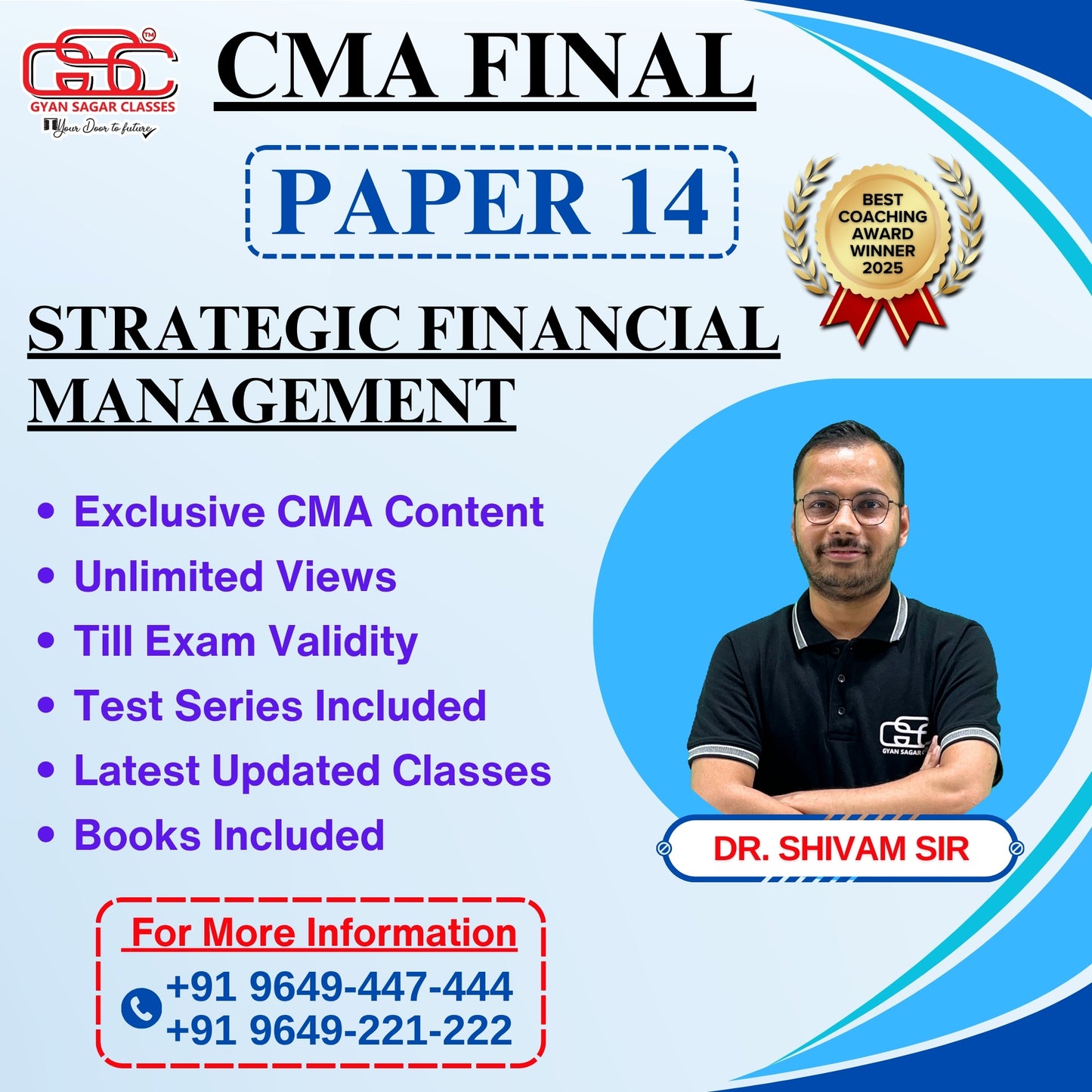CMA Cart
CMA Final Strategic Financial Management (SFM)
CMA Final Strategic Financial Management (SFM)
Couldn't load pickup availability
Product Information
| Mode |
Download Link with Hard-Book
|
| Duration | Lectures:- 150 (Duration:- 130 – 140 Hours) |
| Video Language | Hindi |
| Faculty Name | MBA Shivam Sir |
| Course Material Language | English |
| Video Run on | Computer / Laptop / Android Mobile (Video Lectures Do Not Run on Apple Device Please Check FAQ) |
| Study Material | CONCEPT BOOK + 2 VOLUME QUESTION BANK |
| Package Details | Video Lectures + Study Material |
| Exams validity | Till Exam |
| Doubt Solving Facility | Email, WhatsApp, Call |
| Delivery Free Delivery | Non Cancellable |
| Product Dispatch | Within 24 to 48 Working Hours |
| Total No. Views | Unlimited Views (Till Exam) |
Content As Per Syllabus
SECTION A : INVESTMENT DECISIONS
Module 1 Investment Decisions, Project Planning and Control 1.1 Measuring Cash Flows, Discounted Cash Flow Technique for Project Evaluation 1.2 NPV and IRR - Conflict and Resolution, The Modified Internal Rate of Return (MIRR), Comparing Projects with Unequal Lives, The Concept of Abandonment Value, Modified Accelerated Cost Recovery System (MACRS) 1.3 Inflation Adjusted Cash Flow Forecasting in Capital Budgeting 1.4 Capital Rationing for Divisible and Non – divisible Projects (with Application of Integer Programming) 1.5 Social Cost Benefit Analysis
Module 2 Evaluation of Risky Proposals for Investment Decisions 2.1 Risk Analysis in Capital Budgeting - Certainty Equivalent Approach, Risk Adjusted Discount Rate, Expected NPV, Standard Deviation of NPV and Use of Normal Distribution, Decision Tree Analysis, Options in Capital Budgeting 2.2 Sensitivity Analysis 2.3 Scenario Analysis 2.4 Monte Carlo Simulation
Module 3 Leasing Decisions 3.1 Lease Financing – Evaluation of Lease vs. Buy Options 3.2 Break-Even Lease Rental Determination and Implicit Rate 3.3 Cross Border Leasing, Sale and Lease Back
Module 4 Securitization 4.1 Definition and Concept and Benefits of Securitization 4.2 Participants in Securitization 4.3 Mechanism and Problems of Securitization 4.4 Securitization Instruments
SECTION B: SECURITY ANALYSIS & PORTFOLIO MANAGEMENT
Module 5 Introduction 5.1 Fundamental Analysis 5.2 Technical Analysis
Module 6 Equity and Bond Valuation and Evaluation of Performance 6.1 Equity Valuation - Discounted Cash Flow Based Valuation, Relative Valuation using Multiples and Weights 6.2 Bond Valuation - Prices & Yields
Module 7 Mutual Funds 7.1 Meaning, Advantages and Disadvantages, Structure and Types 7.2 Regulations 7.3 Computation of NAV 7.4 Evaluation of Performance and Movements in Security Values and NAVs of Mutual Funds for Investment Decisions: Perspective of AUM Managers and Individual Investors 7.5 ETF, REIT, InvIT
Module 8 Portfolio Theory and Practice 8.1 Portfolio Return and Risk, Systematic and Unsystematic Risk, Diversification strategies (Naïve vs the Markowitz Model) 8.2 Optimal Portfolio, Efficient Frontier, Capital Market Line 8.3 Principles of Asset Allocation, Active and Passive Asset Allocation
Module 9 Asset Pricing Theories 9.1 Single Factor and Multifactor Asset Pricing Theories: CAPM and APT 9.2 Concepts and Applications (including Levered Beta and Unlevered Beta)
Module 10 Portfolio Performance Evaluation and Portfolio Revision 10.1 Conventional Performance Evaluation 10.2 Market Timing and Style Analysis
Module 11 Efficient Market Hypothesis 11.1 Definition 11.2 Forms of Market Efficiency 11.3 Implications
SECTION C: FINANCIAL RISK MANAGEMENT
Module 12 Risks in Financial Market
Module 13 Financial Derivatives – Instruments for Risk Management 13.1 Introduction to Financial Derivatives 13.2 Forward and Futures – Meaning and Difference, Pricing, Stock Futures, Index based Futures, Hedging through Futures 13.3 Options 13.4 Swaps 13.5 Interest Rate Derivatives – Forward Rate Agreement, Interest Rate Futures and Options, Caps, Floors and Collars
SECTION D: INTERNATIONAL FINANCIAL MANAGEMENT
Module 14 The International Financial Environment 14.1 International Financial Institutions and Markets 14.2 Sources of Foreign Currency
Module 15 Foreign Exchange Market 15.1 Introduction – Structure of Foreign Exchange Market 15.2 Foreign Exchange Rate – Meaning, Determinants, Equilibrium Exchange Rate, Exchange Rate Quotations – Meaning, Direct vs. Indirect Quote, American vs. European Quote, Bid-Ask Rate and Spread, Cross Rates 15.3 Segments of Foreign Exchange Market – Spot Market (including two and threepoint Arbitrage), Forward Market 15.4 Foreign Currency Derivatives 15.5 Parity Relationships
Module 16 Foreign Exchange Risk Management 16.1 Transaction Exposure 16.2 Translation Exposure 16.3 Operating Exposure
SECTION E: DIGITAL FINANCE
Module 17 Digital Finance 17.1 Meaning, Traditional Finance vs. Digital Finance 17.2 Digital Finance Ecosystem 17.3 Regulation and Governance in a Digital Finance Environment
Share


